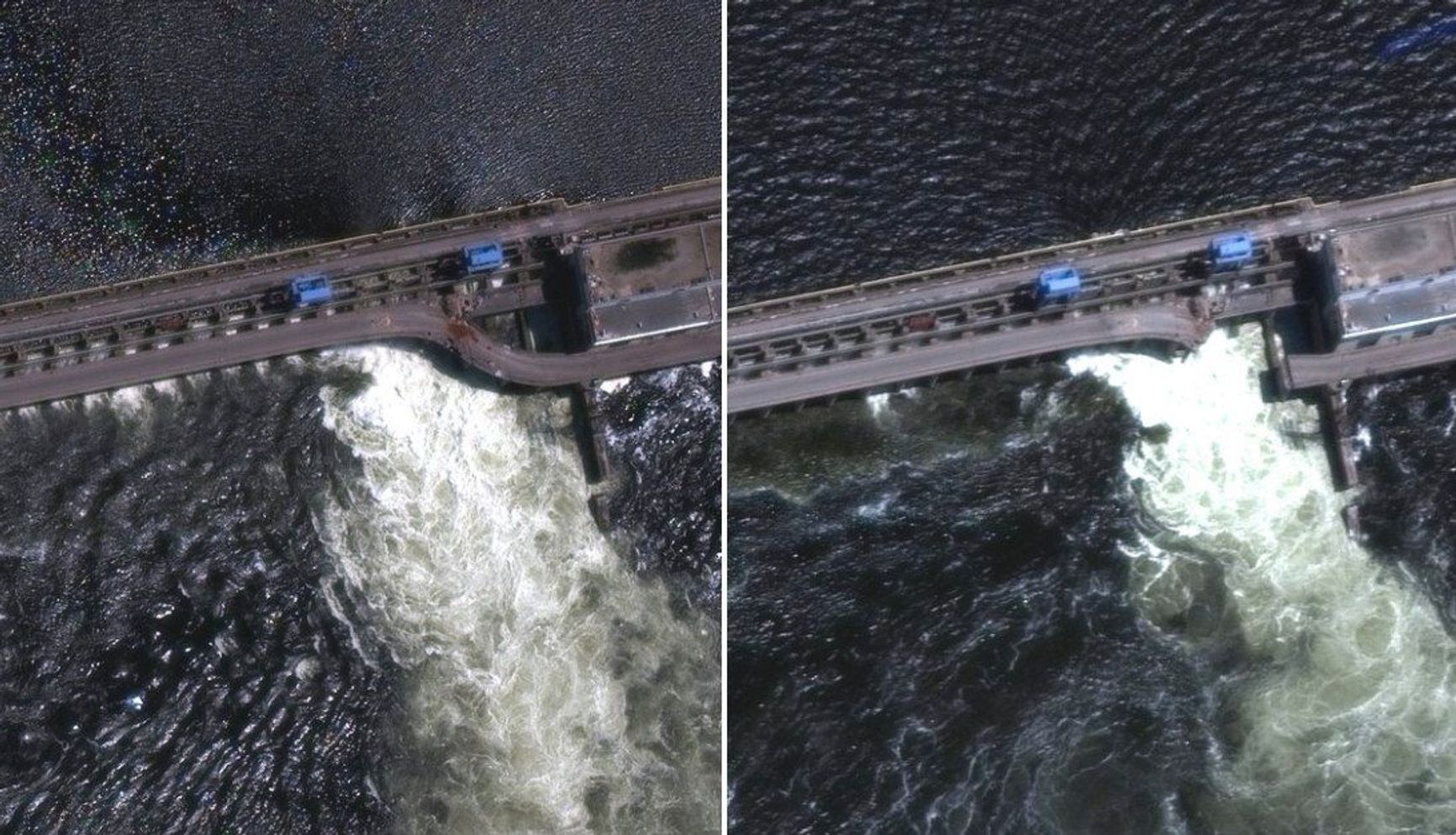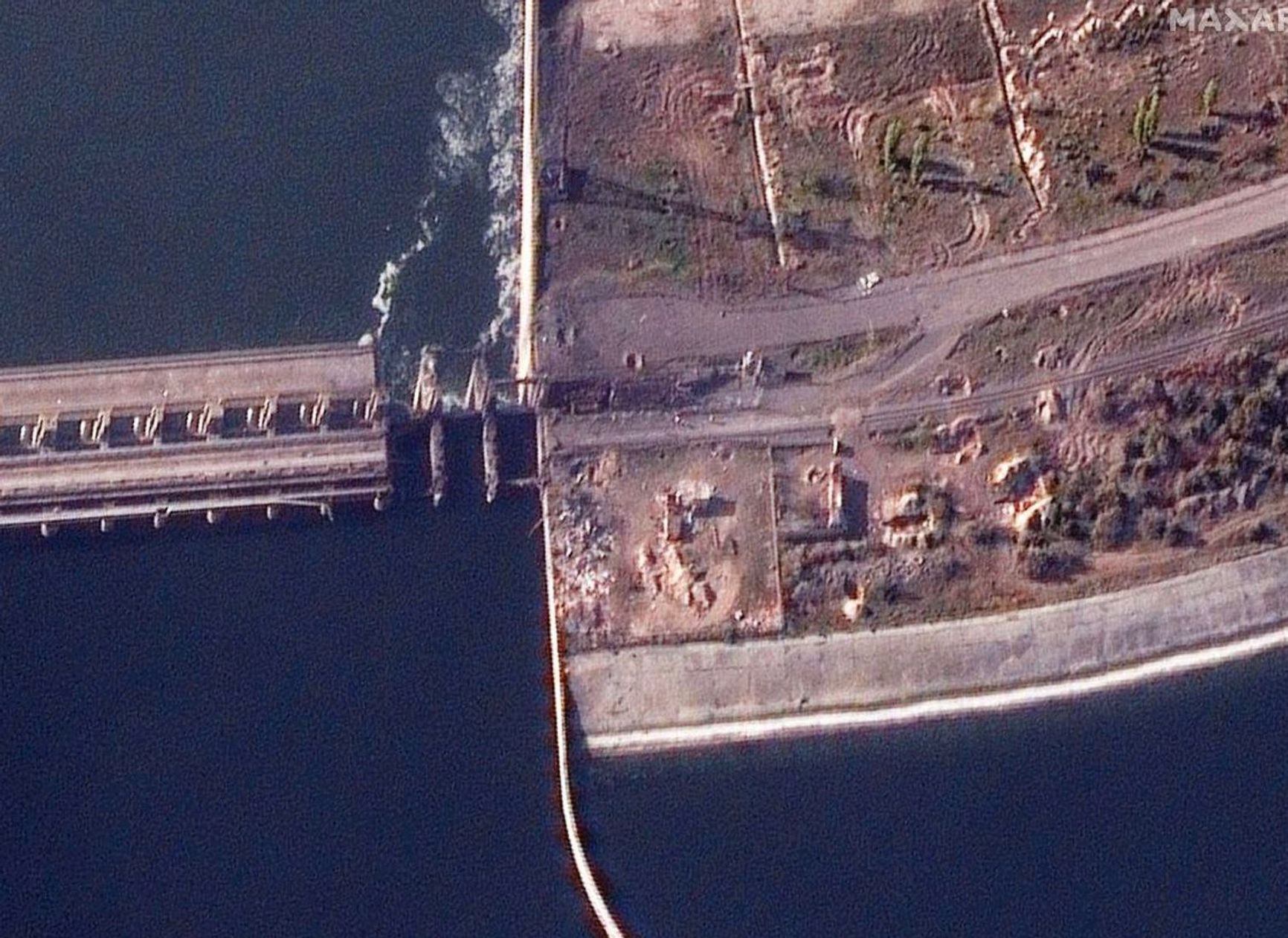
Local residents in the town of Nova Kakhovka in Ukraine’s Kherson region heard explosions and saw a signal flare before the Kakhovka HPP dam broke, and discussed what happened on the morning of June 6 in the city's Telegram channels and chat rooms. After the dam broke and the plant went underwater, Russia and Ukraine blamed each other for the destruction, with both sides rejecting claims of their involvement in the dam’s collapse. The exact causes of the destruction are unknown, and the Russian occupation authorities will make no effort to investigate the incident, due to a resolution passed a week before the breaking of the dam. Read more in The Insider's summary of events surrounding the destruction of the Kakhovka HPP on June 6.
What are the locals saying?
Since the morning of June 6, people began to report hearing explosions in a local Telegram channel about Nova Kakhovka with over five thousand participants. Some had lost their water supply, and some had already suggested that the dam might have burst.
Residents argued among themselves, some claiming that if the dam had exploded, all services – including Ukraine’s State Emegerncy Service (DSNS) – would have alerted them. One resident wrote in Ukrainian at 2:45 Moscow time that he saw a flare.
“The water is very noisy ... very loud, I've never heard such a thing. I'm scared of something... The flares are orange flares.”
Resident Lydia Kuznetsova responded: “But that's water, but why is it so loud? We can be without light again with these booms.”
Several dozen people commented that they could not sleep because of the noise, and were worried that something had happened. However, other residents reassured them and claimed that they did not see a “global flood,” did not hear explosions, and asked them not to cause panic.
“This is what [they do] for the weak people, to panic, move out and vacate their homes, it's like you're the first day of the occupation.”
It is worth noting that the Russia-installed mayor of flooded Nova Kakhovka also initially called the destruction of the dam “nonsense” and claimed that “everything is normal.” The Russian authorities did eventually announce an evacuation, with over 800 people already confirmed as evacuated from the region. 17,000 people live in coastal settlements on the right bank of the Dnipro River, while another 25,000 live near the water on the occupied left bank. Videos of flooded parts of the city are being circulated on social media, and eyewitnesses have captured video footage of a private home floating down the Dnipro.
What caused the destruction of the dam?
After analyzing satellite images before and after the Kakhovka HPP broke, several OSINT analysts suggested that the dam might have collapsed due to earlier damage, not because of an explosion. Serious damage to the dam can be seen in images dated June 5, as well as in footage from the day before.

The Washington Post and Financial Times journalists Evan Hill and Christopher Miller also commented on the damage on Twitter. They pointed out that between May 28 and June 5, parts of the road above the dam and the sluice gates were damaged or destroyed. Hill commented that shortly before the dam broke, water levels in Kakhovka Reservoir reached unprecedented levels. This could have happened because Russia kept too few floodgates open, wrote The New York Times.
Bellingcat investigative journalist Aric Toler tweeted: “I'm far from an engineer, but maybe Mother Nature destroyed the dam, not Ukrainians or Russians?” However, he later deleted the tweet.
On his part, Ruslan Leviev, founder of the investigative organization Conflict Intelligence Team (CIT), claimed that judging by the discharge of water under the fallen piece of road, the dam could have gradually collapsed on its own. “Maybe that's what caused the piece of road to fall, given that there was a hole there a long time ago. I would look at even older photos to see how long ago this water discharge started appearing,” the expert wrote. Leviev also referred to a video, which likely shows a former employee of the power plant showing the power plant building and says that there was no strike.
However, Natalia Humeniuk, press secretary of the Ukrainian army’s Operational Command South, claimed that the HPP was blown up, adding that the explosion did not occur due to a missile strike, but a blast from within the plant building. By blowing up the HPP, the Russian troops decided to slow down the counterattack of the Armed Forces of Ukraine, said Humeniuk. The Ukrainian mayor of Nova Kakhovka, Volodymyr Kovalenko, said that the machine hall at the hydroelectric plant had been blown up.
Mykhailo Podolyak, adviser to the Head of the Office of the President of Ukraine, also claimed that the dam was blown up by Russia during a stream on journalist Alexander Plyushchev’s YouTube channel. Podolyak claims that the explosion was carried out by the Russian army’s 205th Motorized Rifle Brigade in order to affect the AFU’s counteroffensive.
State of the dam and hydroelectric power plant
The dam went underwater a few hours after it broke, according to a video published on Telegram by pro-Russian military correspondent Yuri Kotenok:
“As of 10:48 Moscow time, the Kakhovka HPP is completely flooded. In Nova Kakhovka, the water level rose to 10 meters.”
Ukrainian media project and Radio Liberty affiliate Skhemy also published satellite images of the Kakhovskaya HPP dam before and after the explosion (dated June 4 and 6).

Ukrhydroenergo, a Ukrainian state corporation that manages the country’s claims that the Kakhovka hydropower plant is completely destroyed and cannot be restored. The Russian state agency TASS writes that half of the spans of the Kakhovskaya HPP have already collapsed and the collapse continues.
Kakhovka dam sustained multiple ordnance strikes prior to June 6
The Kakhovka HPP and the dam have been struck with explosive projectiles more than once, with the collapse of the dam was predicted as early as fall 2022.
On November 11, 2022 the American satellite imaging firm Maxar published satellite images of the bridge at Kakhovka HPP and Darivka bridge over the Inhulets River. The images show that several spans of the bridge at the hydroelectric power plant are missing. At the time, CNN reported that the dam across the Dnipro was damaged, with water flowing out of three sluice gates. According to the channel, the last explosions on the dam occurred on November 10 after the retreat of Russian troops.

Experts interviewed by The Insider noted that the destruction of the dam made no military sense for Ukraine. At the same time, it was predicted at the time that Russia might take such a step if it was forced to abandon the right bank of the Dnipro River in Kherson, which eventually occurred.
Russia's ruling a week before the accident
The Insider earlier drew attention to the fact that a week before the explosion at the Kakhovka HPP, the Russian government passed legislation permitting not to investigate accidents at dangerous facilities in the so-called “DPR” and “LPR”, as well as the Zaporizhzhia and Kherson regions that occurred due to “military actions” and “terrorist acts.”
“Until January 1, 2028, the technical investigation of accidents at hazardous production facilities and accidents at hydraulic structures, which occurred as a result of military actions, sabotage and terrorist acts, shall not be carried out,” read Russian Government Decree No. 873, available on Russia’s official legal information website.
The decree came into force on May 31.
The document also contains clauses that up to September 1, 2023 and up to March 1, 2024 multiple clauses of Russia’s Federal Law “On the industrial safety of hazardous production facilities” and “On the safety of hydraulic structures” will not apply at facilities in the “DPR,” “LPR,” Zaporizhzhia, and Kherson regions.
As Ilya Shumanov, director of Transparency International – Russia, noted in a conversation with The Insider, the clauses could have been lifted not in order to hide the destruction of the dam, but because there was no possibility to evaluate the facility due to the lack of technical documents. Shumanov noted that Ukrainian specialists took the documents with them when they were evacuated from the facility. The people that Russia has put in charge of maintaining the plant do not know its production capacity, what it’s connected to, and they have no trained specialists to assist them in finding out. The law was passed “just in time” to remove responsibility from the people who now make management decisions at the plant, Shumanov said.
“Apparently, people had access to information that the collapse would take place, so they brought the legislation up to speed in advance so that they wouldn’t be asked any questions,” Shumanov clarified.
Reaction to the collapse
Russia’s Investigative Committee opened a criminal case over an alleged “terrorist attack” after the destruction of the Kakhovka HPP dam.
“As a result of criminal actions on the part of Ukrainian armed formations, the Kakhovka hydroelectric power plant was destroyed, resulting in the flooding of settlements in the Kherson region,” the agency said.
Ukrainian President Volodymyr Zelensky addressed the participants of the Bucharest Nine Summit with a statement that Ukraine could not have blown up the dam of the Kakhovka HPP. According to Zelensky, Russia has been in control of both the dam and the entire plant for a year. The dam had been mined by the Russian side in advance, the Ukrainian President said, pointing out that it was impossible to destroy it from the outside – including by shelling.
“Russia detonated a bomb of massive environmental damage. This is the largest man-made environmental disaster in Europe in decades. [...] And that is why Russia's defeat – a defeat that we will ensure in any case – will be the most significant contribution to the security of our region, our Europe, and the world.”
According to the French satellite monitoring agency Hydroweb (Theia), the water level in the Kakhovka Reservoir rose sharply before the destruction of the dam and reached its maximum level over the past 7 years.
Czech Foreign Minister Jan Lipavsky compared the Russian attack on the Kakhovka HPP to “the use of weapons of mass destruction against civilians.”
Charles Michel, the Head of the European Council, called the destruction of the dam a war crime and said that Russia and its proxies would be held accountable.